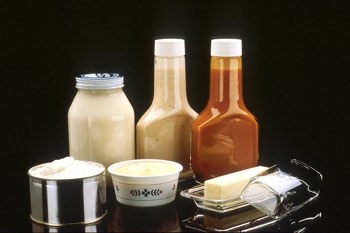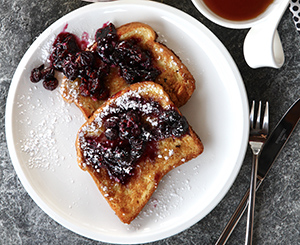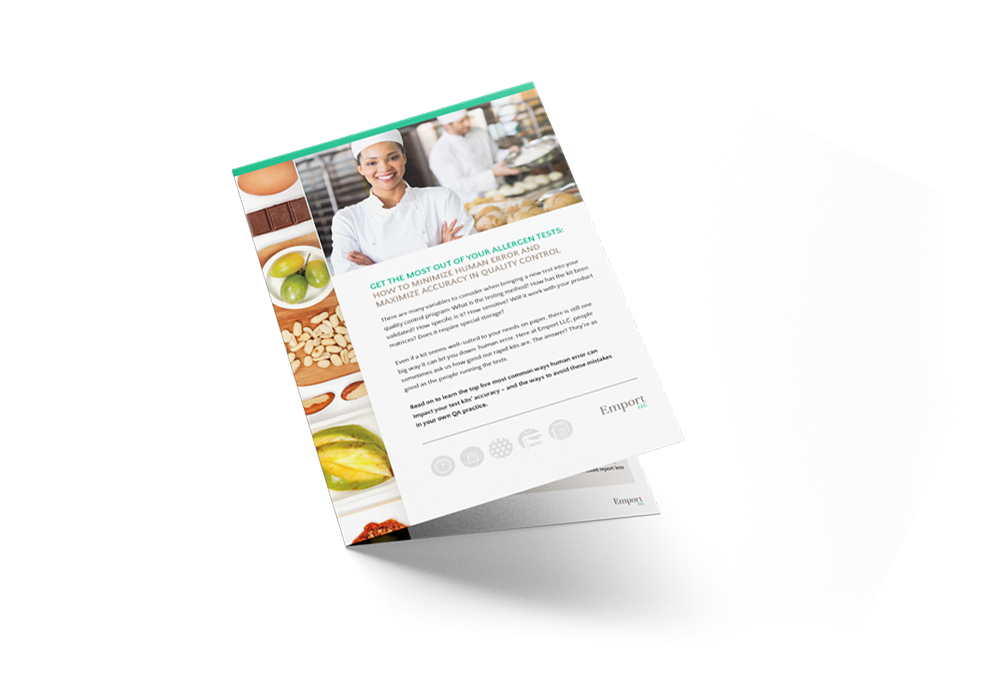An easy demonstration of gluten contamination for the School Science Fair

If you have a celiac person living in your house alongside “gluten-eaters”, does he or she have their own special jars of condiments and dips? We bet they do! After all, the knives and spoons used to spread jam or mayo on bread, or the flour pita chips used for scooping up dips can leave gluten containing particles in the original container. Contamination is a very real concern for someone with celiac or a sensitivity to gluten, and even a crumb can trigger a reaction. We’ve developed a school science fair project suitable for students of all ages that uses GlutenTox Home to demonstrate the risks of shared containers.
After all, a person with celiac disease isn’t being selfish if they don’t want to share their strawberry jelly, they just don’t want to get sick!
Enjoying a hamburger or bagel in a public setting like the school cafeteria, or while visiting a friend, can create a challenge for celiacs of any age. Even if the ingredients on the menu are inherently gluten-free, shared condiments can present a hazard all their own.
Testing shared condiments can demonstrate clearly to a classroom of students how easily cross contamination can take place.
Be sure to read through our Tips carefully before beginning your project!
Your hypothesis: Condiments used in places where gluten-containing foods are present can present a potential gluten contamination hazard, whether in the home or in public.
What you’ll need:
- A collection of at least 5 samples of shared condiments and toppings (see below)
- Enough GlutenTox Home tests to have one test per sample
- One individually wrapped plastic utensil per sample
- One sealable collection container (plastic baggies, small Tupperware, test tubes etc) per sample
Any inherently gluten-free item that is packed in tubs or jars can make a good sample:
Butter or Margarine
Cream cheese or other spreadable cheese
Mayonnaise (in jars)
Jams and Jellies
Peanut Butter
Mustard (in jars)
Relish
Hummus
 Whether you collect samples from your own home, the homes of family, friends, or neighbors, or from local commercial kitchens (cafeteria, summer camp, etc.) is up to you. The key is to find samples that are being used by people who eat gluten and who do not take any special precautions to avoid gluten contamination. For best results, find samples that have been in use for a while and are at least 25% used up.
Whether you collect samples from your own home, the homes of family, friends, or neighbors, or from local commercial kitchens (cafeteria, summer camp, etc.) is up to you. The key is to find samples that are being used by people who eat gluten and who do not take any special precautions to avoid gluten contamination. For best results, find samples that have been in use for a while and are at least 25% used up.
You may want to identify one type of sample – for example, jelly – and collect 5+ different jellies from different locations. Or you may want to collect 5+ different condiments from a smaller number of locations. Whatever works for you!
Method
The following steps are a suggestion, but feel free to modify the experiment in whatever way you’d like.
Step 1
To collect a condiment sample, use a new plastic utensil to scrape or scoop the top layer of the condiment into a sealable collection container. You’ll need to have at least 1g of sample per test. For reference, try to collect a minimum of 1 teaspoon of sample per test you plan to run. Label all of your samples clearly.
You may also want to collect information like: a photograph of the open container before you collect your sample; a list of the ingredients in the food; whether or not the food is labeled gluten-free; details about the person who owns the food, etc.
Step 2
You can collect all of your samples and then test, or you can test samples as you collect them. Either way, you’ll want to test each sample for gluten at 5ppm and record the results. See some tips, below, to ensure the best possible results.
Step 3
(Optional) If some of your tests returned positive results, you may wish to purchase duplicates of the items from the grocery store and test them in their original, uncontaminated state.
Alternative / Additional
Instead of going out to identify gluten cross-contamination “in the wild”, you may want to artificially create the contamination in your own home. To do this, purchase one or more condiments as well as packages of typical gluten-containing items that pair with them. For example, a loaf of bread and a tub of butter or jelly. Or, a package of soft pitas and a tub of hummus.
Test the gluten-free condiment first, to establish your baseline test.
Then, “use” the food. You may want to invite some gluten-eating friends over to help! Using the same knife, spread jelly on several slices of bread. Or dip several pieces of pita into the tub of hummus. You may want to collect samples after different levels of exposure (eg, a sample after buttering 1 slice of bread, another after 5 slices in a row, another after 10 slices in a row).
Tips for successful testing!
- We suggest you test for gluten at the lowest threshold of 5ppm. Most importantly, be consistent with all your tests.
- Prepare your samples carefully and organize all your materials before you begin!
- It’s important to analyze the test strips promptly at 10 minutes. After that, results can appear to shift: faint positives can fade or appear, and strong positives will fade a bit over time.
- Taking a picture of the test strips at the ten minute mark is a great way to document your findings.
- If you want to repeat the experiment, you’ll need to plan for purchasing additional tests.
We always love learning about other ideas for gluten-free science fair projects; please feel free t0 contact us any time to discuss your student’s plans for his or her own gluten-free experiments. We may be able to troubleshoot or provide suggestions on how to structure the experiment for maximum gluten-free learning.
If your child has already completed his or her project, we’d love to see it! Email us details if you’d like your child to be considered for a spot as a featured guest blogger on our site.

Need to test for gluten at home?
Commercial-quality, user-friendly. Clear results in less than 20 minutes.


